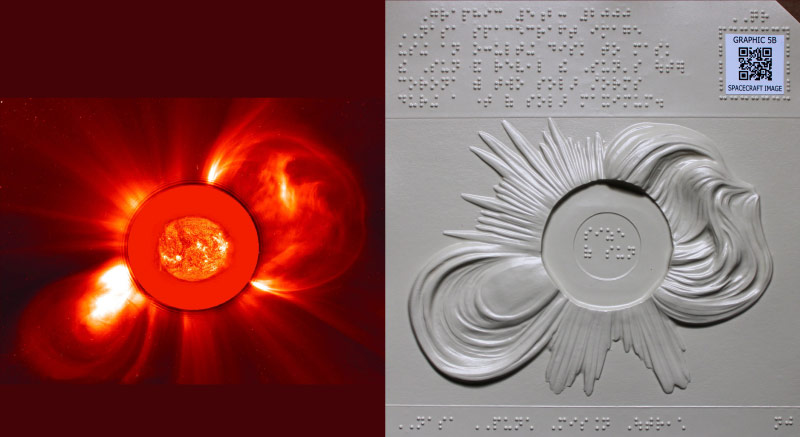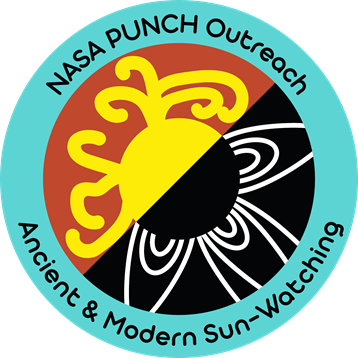Graphic 5b: 2000 NASA spacecraft image using an occulting disk to mask the Sun and reveal its outer corona with two solar storms during a time of solar maximum
Welcome to Tactile Graphic number 5b – the 2000 NASA spacecraft image! This is the last of seven images supporting the Petroglyph Inquiry.
Whether you are engaging fully with the Petroglyph Inquiry (recommended) or just browsing the PUNCH Outreach set of seven images in a random order, we strongly encourage you to begin by reading the 2-page section entitled Essential Background if you have not already done so.
Guided Description of the Tactile Graphic number 5b

Graphics 5a and 5b are a pair of spacecraft images, one at solar minimum and one at solar maximum. You task is to compare them. Please explore Graphic 5a if you have not already done so using the link in the navigation menu below.
The tactile image between the Braille areas at the top and bottom of Graphic 5b represents a NASA spacecraft image of the solar corona made in 2000 near a time of solar maximum.
The inner recessed ring represents the scaled size of the Sun. The outer ring represents the field of view blocked by an occulting disk that is part of an instrument aboard the spacecraft called a coronagraph. A coronagraph blocks the light of the Sun to allow us to observe the corona at any time, not just during natural eclipses on Earth.
The NASA spacecraft carrying the coronagraph is called the Solar and Heliospheric Observatory, or SOHO for short. To make the most detailed images of the outer corona, the occulting disk of the SOHO coronagraph must also block the light a bit farther out from the solar disk. This means we cannot observe the inner corona. But during a natural total eclipse of the Sun the inner corona remains visible and so ground-based eclipse observations remain an important and complementary way to study the Sun.
Please pause to explore the tactile image carefully, be sure to find the features and address the questions listed below:
- The inner recessed ring representing the scaled size of the Sun
- The outer ring representing the field of view blocked by the coronagraph’s occulting disk
- Are coronal streamers extending out from most directions around of the central disk?
- Do you detect any curve or distortion that might represent the presence of a CME in this image? Where?
Compare the spacecraft images represented in Graphics 5a and 5b to notice the main difference between them. Notice that in 5a at solar minimum, coronal features are expressed out to the sides and not so much at the top and bottom of the central disk. Whereas in 5b there are coronal features and structures all around the central disk. This is the basic distinction between the appearance of the corona during a time of solar maximum compared to a time of solar minimum.
This difference in the overall structure of the corona between solar maximum and solar minimum is evident whether or not a solar storm is present in the corona. Solar storms called Coronal Mass Ejections (CMEs) may curl or otherwise distort the usual radial features of the corona.
In Graphic 5a, there are no curls or other distortions to indicate the presence of a CME. But in Graphic 5b there are a lot of loops, curls and distortions, representing two CMEs in progress at different phases of their eruptions. This image is remarkable because it is unusual to capture more than one solar storm erupting at the same time, even for spacecraft that are constantly observing the Sun.
At the lower left, find a bubble-like feature with loops around it. This is a more detailed example of the bubble-like solar storm in progress observed in the lower right of the 1860 hand drawing in Graphic 2.
At the upper right, notice the especially bright (raised) curls and swirls of the outer corona where another CME is farther along in the process of exploding tons of material out into space.
Notice also the straight outward rays of the corona in the areas around the disk where there are no CMEs in progress.
REFLECTION and DISCUSSION
What do you think? Do you think the curlicues of the petroglyph could all be representing CMEs in the corona? Is it fair to compare the curls and curves of a CME in a space-based coronagraph image of the outer corona with a ground-based observation of the inner solar corona during a total solar eclipse?
Graphics 5a and 5b: ADDITIONAL COMMENTARY for those doing the PETROGLYPH INQUIRY
As you consider the synthesis questions and answers below, please add to your list of strengths, weaknesses, ideas, and questions regarding the “1097 eclipse” hypothesis for interpreting the Chaco petroglyph (Graphic 1):
What does a Coronal Mass Ejection look like in the solar corona? How would such a solar storm appear to Earth-based observers? Can storm-like distortions to the solar corona be observed with the naked eye from the ground?
Our set of tactiles has provided evidence that CMEs have been observed in progress in the corona during total solar eclipses and in space-based coronagraph images. The SOHO coronagraph image (Graphic 5b) shows how curled and distorted outer coronal rays can become during a solar storm.
But spacecraft coronagraph images are not representative of what is perceived by a ground-based observer during eclipse totality. Eclipse photographs see the inner part of the corona – a part that is blocked by the coronagraph’s occulting disk. It is not fair to compare the two directly except in the most general sense that CMEs curve or distort the radial rays of the corona. It is possible to try matching a feature observed in the low corona during an eclipse to concurrent coronagraph observations that pick up on the same feature once it has moved farther from the Sun.
Earth-based observers during eclipse totality have detected oval-like features such as in the lower right quadrant of Tempel’s hand drawing in Graphic 2. We know Tempel used a telescope. Other observers along the 1860 path of totality drew or described in words different versions of an especially long and/or curled tail-like feature in the same quadrant where Tempel drew the oval. Could such a feature be indicative of a CME as well, perhaps in a different phase of its eruption from the Sun? We do not know for sure whether any of the 1860 observers noticed a distortion of the corona with their naked eyes instead of with magnification the Chaco observers would did not have.
Which of the petroglyph’s features could represent the presence of a solar storm (Coronal Mass Ejection)? What do the curlicues represent? What about that long tail in the lower right?
When we look at curls and loops of the double CME in the SOHO coronagraph image in Graphic 5b, it is tempting to liken them to the curlicues of the petroglyph. However, as described in answer to the previous question, is not reasonable to liken the outer coronal observations from space to naked-eye eclipse observations from the ground. Moreover, it is implausible to suggest that each of the curlicue structures represents a CME. It is rare enough that two CMEs are observed at once as in Graphic 5b.
Graphic 3 offered the magnification of a prominence. Prominences can be very curvy and looped and on occasion are distributed all around the Sun. Could the curlicues represent prominences instead of CMEs? Howard Russell Butler used binoculars to discover and paint the detailed structures of prominences. Without magnification, could the Chaco observers have perceived the details of numerous prominences around the Sun’s disk during the 1097 total solar eclipse and then represented them as the curlicues of the petroglyph? Perhaps because 1097 was a time of solar maximum the prominences were especially large and more visible than they usually are?
When queried informally by Dr. Morrow in April 2024, Dr. Malville suggested the distinctive double curlicue feature above the central disk of the petroglyph as a candidate representation of a CME in the corona. Could that feature be construed as part of a curved or partial-oval structure indicating a CME in progress? Dr. Morrow suggests that the especially long and curved tail in the lower right of the petroglyph is the most promising indicator of a CME, akin to the curved tails (drawn in the same lower-right position as the oval feature) by observers other than Tempel along the 1860 eclipse path. Such curved and elongated features have also been observed in contemporary eclipse photography in association with CME eruptions.
Dr. Morrow’s ongoing research into possible solar symbols in pottery design suggest the possibility that a symmetric curlicue motif may already have been established as a representation of the Sun. In that case, it is the asymmetries and distortions on this motif that could represent what was new and different about what Chaco residents may have observed during 1097 eclipse totality.
On the other hand, the curlicue petroglyph is unique among known rock art in the US Southwest, and it is peculiar even when compared to other Sun-like rock carvings or paintings. The intricate design is certainly easier to paint on a pot than it is to carve into stone. More research is needed to determine how commonly the curlicue motif was rendered on pottery across the time and space of the Chaco region and how this may correlate with the 1097 path of totality.
But maybe there is no storm in the corona being represented by the petroglyph and instead the curlicues represent an eclipse peeking through Earthly storm clouds. Or maybe the petroglyph’s curlicues represent something entirely simpler, like the petals of a culturally important flower.
REFLECTION and DISCUSSION
What do you think? Please make final additions to your list of strengths, weaknesses, ideas, and questions regarding the “1097 eclipse” hypothesis for interpreting the Chaco petroglyph (Graphic 1). Organize your notes for discussion or presentation with others.
OPTION
If desired send an email report to punchoutreach@gmail.com. Your report should include a summary of your well justified opinion regarding the “eclipse hypothesis” for the curlicue petroglyph. It may be accompanied by a digital copy, image, or vocal recording of your well-organized notes (strengths, weaknesses, ideas, questions). Thoughtful reports will be recognized in our presentations and research papers.
Please also be welcome to send any feedback on your experience of the Petroglyph Inquiry!
